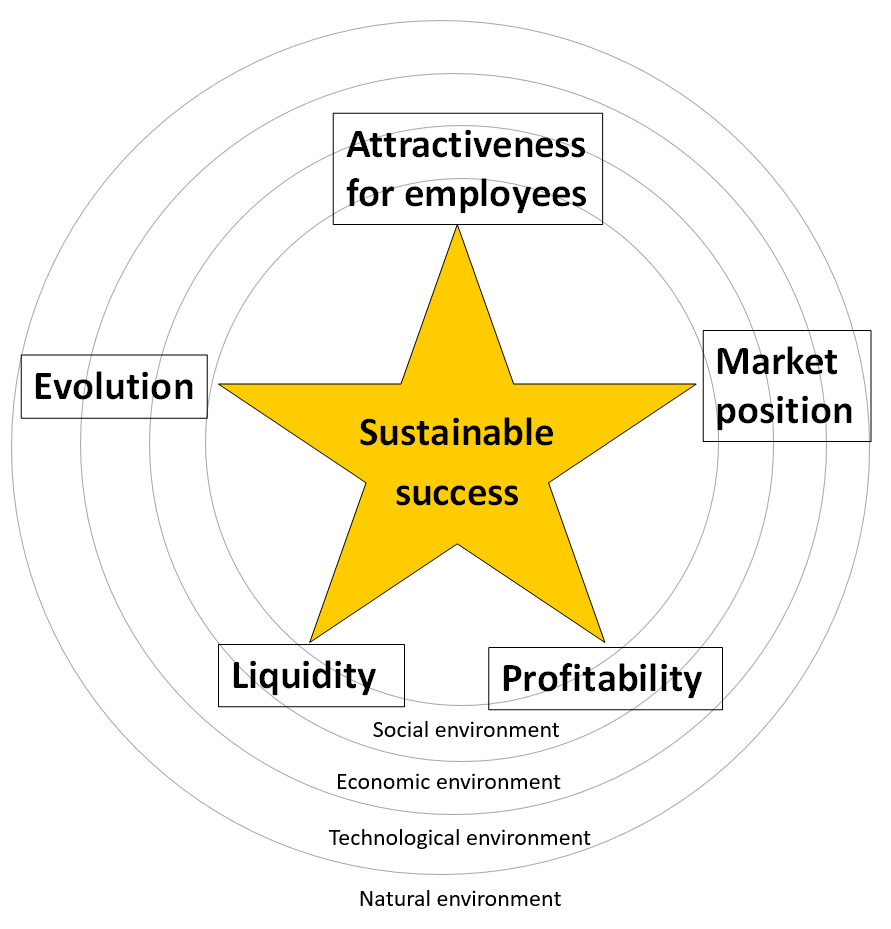Presumed Environmental Changes are Crucial for Management Control
Every organization is constantly exchanging with its environment. “Out there” are the customers, potential employees, suppliers, financers, the state and other public institutions with their specifications and laws, as well as the social groups with their changing perceptions. All this is embedded in the natural environment.

How can environmental factors be structured in such a way that management can relate them directly to its strategic and operational decisions? We use structuring in partial environments (taken from Hans Ulrich, p. 31). Four sub-environments are distinguished:
Natural environment:
This includes everything that happens on earth, including that which is caused by extraterrestrial influences. Although humans can disturb the development of the natural environment, they cannot directly influence it for the good.
Social environment:
Everything that is shaped by behavior, rules and interaction between people. This also includes developments and specifications of governmental and international organizations, changes in interpersonal rules of conduct, changes in mentality and changes in social interaction.
Technological environment:
Changes in sales and procurement markets, new technologies and application areas, and changes in potential competitors.
Economic environment:
Whoever provides financial resources to build or operate organizations wants to be compensated for sacrifycing other investments or consumption. He considers whether his use of funds will be remunerated in line with market conditions. To do this, he weighs the security of the cash or value return against the interest that can be realized with other investments. This in turn depends on the possible compensation of alternative investments and the risk to be taken.
Example topics in the sub-environments
When establishing or expanding a business, opportunities and risks must be identified and weighed up. For this purpose, they must be documented and assessed.
The management control system is the appropriate place to record this documentation and the resulting findings for the management bodies. The four environmental dimensions help to structure, sort and weight the planning statements. They also help to consider all environmental variables when defining the development lines. Examples include:
-
- What influencing factors from the natural environment could make it necessary to adapt our business model? Which elements could make success impossible or, on the contrary spur it on?
- To what extent do other structures of living together (e.g., patchwork families, work-life balance, less full-time employment) affect our applied management processes as well as the availability of our employees? Will the increasing density of legal regulations generate higher personnel requirements or even make the profitable continuation of our current business impossible?
- Are new application technologies, raw materials and manufacturing processes emerging that will open up new sales opportunities for our products and services? Are there any recognizable saturation or substitution tendencies in the market that could render our existing offerings obsolete? Do new technological standards, e.g., operating systems of computers, require an adaptation of our own products and services?
- Are there any developments to be suspected in the customer acquisition process that could jeopardize our sales success to date or are sales intermediaries conceivable who could help to make our products and services better known? Can the concentration of suppliers in saturated markets endanger our existence? Are our competitors theoretically able to produce their products more cost-effectively than we are?
- What profitability is to be achieved so that existing equity and debt capital providers continue to invest in our business and – if necessary – new investors can be attracted? What is the degree of self-financing needed to be able to make independent decisions even in periods of low profit and to prevent loan terminations?
In the establishment of corporate policy and strategies a link to environmental developments must be created. In our experience, it is helpful to structure the decisions to be made according to the four sub-environments mentioned.
For a more in-depth consideration of the corporate environments, see section 1.1 in the book “Management Control System” (https://management-control.eu/store).
